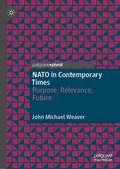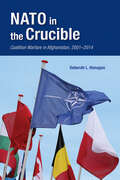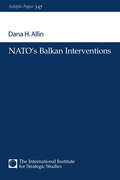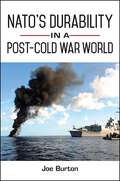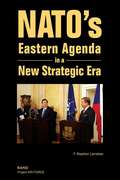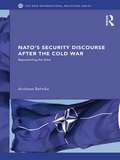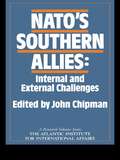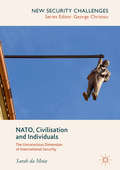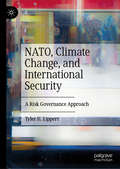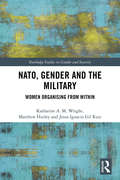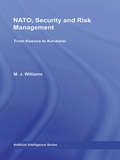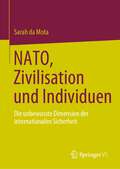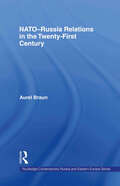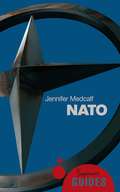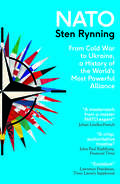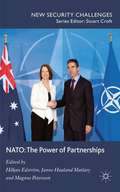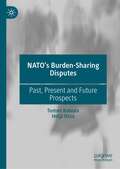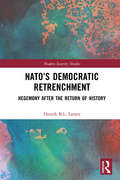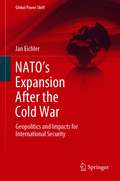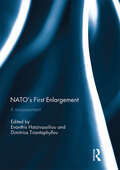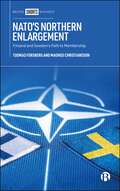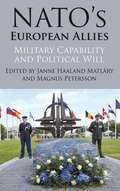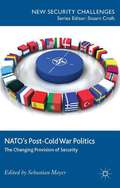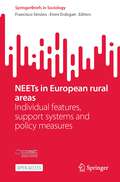- Table View
- List View
NATO in Contemporary Times: Purpose, Relevance, Future
by John Michael WeaverThis book builds on the six years of hands-on experience that the author had while working in the North Atlantic Treaty Organization. It provides an overview and history of NATO, looks at the political and military components of the Alliance, as well as the military command from the perspective of real-world contemporary NATO operations and planning. The author also looks at the military training, lessons, and exercise components and how it prepares forces to support upcoming NATO Response Force (NRF) rotations to ensure that NATO is a viable threat deterrent and responsive organization to both Article 5 and non-Article 5 operations. This book will serve as a primer into the world’s longest enduring Alliance and one that has made an impact on real world operations over the last 20 years in Europe (Bosnia and Kosovo), Africa (Libya), Asia (Afghanistan and Pakistan), and the Middle East (Iraq).
NATO in the Crucible: Coalition Warfare in Afghanistan, 2001–2014
by Deborah L. HanaganWhen the North Atlantic Treaty Organization (NATO) became involved in security operations during the War in Afghanistan, it faced a range of complex challenges, including a highly motivated Afghan insurgency that changed over time and repeatedly defied assumptions.Conflicts within NATO also posed challenges. The alliance brought together a quarter of the world's nations, each with its own goals and interests, in an effort to stabilize an agrarian country that posed no immediate security threat. For more than a decade, through changes in leadership and strategy, the nations experienced bitter disagreements, resentments, and a conflict that escalated to a level of violence and uncertainty few had anticipated.In NATO in the Crucible, Deborah Lynn Hanagan analyzes these challenges and explains how the alliance maintained cohesion despite them. She examines why NATO succeeded in Afghanistan when history suggests most coalitions fracture under such intense pressure. In the end, she argues, member nations summoned the political will and organizational capacity to cooperate and endure. And they agreed, above all, that failure in Afghanistan would be catastrophic—both for NATO and for the world.
NATO's Balkan Interventions (Adelphi series #347)
by Dana H. AllinExamines NATO's Balkan interventions over the entire decade starting with the break-up of Yugoslavia in 1992. Focusing on the wars in Bosnia and Kosovo, it traces the record of early transatlantic failures and later successes as once bitterly divided allies were able, finally, to unite around some basic principles. By the time of the Kosovo intervention in spring 1999, the allies agreed on the necessity of taking sides and using military force in conflicts that were complicated, but far from morally opaque. The book concludes with some lessons around which the transatlantic allies might reasonably hope - despite other pressing concerns - to stay engaged and stay united.
NATO's Durability in a Post-Cold War World (SUNY series, James N. Rosenau series in Global Politics)
by Joe BurtonWhy is it that despite the end of the Cold War and the almost constant controversies surrounding the alliance's role in the world, the North Atlantic Treaty Organization (NATO) is still a prominent and vital player in international security? Joe Burton provides an in-depth analysis of NATO's changing role in the post–Cold War era and its ability to survive, adapt, and meet the needs of its members in an increasingly turbulent, globalized security environment. He offers a historically and theoretically informed account of NATO that isolates the core dynamics that have held the alliance together in troubled times. In particular, he examines a series of processes and events—from the 1990 Gulf War to the rise of the Islamic State—that help explain NATO's continuing relevance.
NATO's Eastern Agenda in a New Strategic Era
by F. Stephen LarrabeeNATO's Eastern agenda faces several challenges, including consolidating the democratic transitions in Central and Eastern Europe, ensuring the security of the Baltic states, developing a post-NATO-enlargement strategy for Ukraine, deepening the Russia-NATO partnership, and engaging the Caucasus and Central Asia. The author also considers NATO's broader transformation.
NATO's Security Discourse after the Cold War: Representing the West (New International Relations)
by Andreas BehnkeThis book analyses the way in which the North Atlantic Treaty Organisation (NATO) defines the West after the end of the Cold War and the demise of its constitutive ‘Other’, the Soviet Union. The book offers a theoretical critique of liberal approaches to security, and focuses on NATO’s construction of four geo-cultural spaces that are the sites of particular dangers or threats, which cause these spaces to be defined as the ‘enemy’ of the West. While this forges a collective Western identity, effectively achieved in the 1990s, the book also includes an analysis of NATO’s involvement in the War on Terror – an involvement in which the Alliance fails to define a coherent West, thereby undermining the very source of its long-standing political cohesion. Contributing to theoretical development within Critical Security Studies, Behnke draws on a variety of approaches to provide an analytical framework that examines the political as well as philosophical problems associated with NATO’s performance of security and identity, concluding that in the modern era of globalized, non-territorialized threats and dangers, NATO’s traditional spatial understanding of security is no longer effective given the new dynamics of Western security. NATO’s Security Discourse after the Cold War will be of great interest to students and researchers of International Relations, Critical Security Studies and International Organizations.
NATO's Southern Allies: Internal and External Challenges (An\atlantic Institute For International Affairs Research Volume Ser.)
by John ChipmanThis book analyses the internal sources of foreign policy within those NATO states whose primary security concerns lie in the southern area of the Alliance. It takes a careful look at foreign and defence policy formulation and assesses the special perspective of each of these countries inturn and the military threats that they face. Attention is paid to the role of the military in society, especially in the geographically peripheral states, as the Alliance seeks to adapt to a possible shift southward of some of its security concerns. A full understanding of the politics in each of these states is essential to determine the relative importance of national and Alliance priorities in each country as the tensions between external policies and internal necessities increase. The book offers an assessment of evolving security requirements in the southern region and of the capacity of NATO Mediterranean states to deal individually and collectively with the changing situation.
NATO, Civilisation and Individuals: The Unconscious Dimension Of International Security (New Security Challenges)
by Sarah Da MotaThis book critically engages with NATO’s two main referent objects of security: civilisation and individuals. By rethinking the seemingly natural assumption of these two referent objects, it suggests the epistemological importance of an unconscious dimension to understand meaning formation and behaviour change in international security. The book provides a historicised and genealogical approach of the idea of civilisation that is at the core of the Alliance, in which human needs, narratives, and security arrangements are interconnected. It suggests that there is a Civilised Subject of Security at the core of modern Western security that has constantly produced civilised and secure subjects around the world, which explains NATO’s emergence around a civilisational referent. The book then proceeds by considering the Individualisation of Security after the Cold War as another stage of the civilising process, based on NATO’s military operations in Bosnia-Herzegovina, Kosovo and Afghanistan.
NATO, Climate Change, and International Security: A Risk Governance Approach
by Tyler H. LippertThis book offers a prospective analysis of the anticipated security consequences of climate change in relation to the North Atlantic Treaty Organization (NATO). Using climate and security literature to complement recent foresight and scenario analysis developed by NATO, the author applies the International Risk Governance Council’s (IRGC) Risk Governance Framework to identify the considerations and actions that could assist NATO in a context where climate and environmental factors more intensively shape security. Tyler Lippert explores how climate change has the potential to increase the need for humanitarian assistance and disaster response, to create tension over shared resources, to renew and enhance geo-political interest in the Arctic, and to deepen concern with respect to the Middle East and North Africa (MENA). Within this new political and environmental reality, NATO must consider how to adapt to meet new demands, prepare for new security challenges, as well as manage unforeseen consequences. Offering a corrective, this book identifies near-term actions for NATO to improve its risk governance posture, providing a basis upon which longer-range policy considerations can be developed. This analysis is only the opening salvo of what is likely to be a complicated process that spans many years, if not decades. However, in mapping the risk governance dimensions to the security and climate nexus from the perspective of NATO, Lippert provides a foundation for risk-based policy planning for NATO. The book will be of immense value to policy and decision makers: NATO leadership and its affiliated organizations as well as to academics across a broad span of subject areas, particularly environmental sociology, defense and foreign policy, and the political sciences.
NATO, Gender and the Military: Women Organising from Within (Routledge Studies in Gender and Security)
by Katharine A.M. Wright Matthew Hurley Jesus Ignacio Gil RuizThis book examines NATO's engagement with gender issues through its military structures. Drawing on newly declassified NATO documents, this volume provides the first comprehensive account of NATO’s long-established engagement with gender issues. These documents bring to the fore the stories of the NATO women and ‘gendermen’ who have organised within NATO across the decades to advocate on gender issues and highlights the continued challenges to pursuing transformative agendas within resistant institutions. The book argues that NATO is an institution of international hegemonic masculinity, with gender norms and values learned by member and partner states through socialisation and the engagement of a masculinist protection logic. It therefore provides an important context for NATO’s recent implementation of the Women, Peace and Security agenda encapsulated in UN Security Council Resolution 1325 and the seven follow-up resolutions. The volume interrogates how Women, Peace and Security has mapped on to NATO’s pre-existing concerns as a global security actor, providing impetus for further critical knowledge building of NATO which centres on gender. This book will be of interest to students and scholars of NATO, Critical Military Studies, Gender Studies, Critical Security Studies and IR in general.
NATO, Security and Risk Management: From Kosovo to Khandahar (Contemporary Security Studies)
by M.J. WilliamsThis new volume explores the crisis in transatlantic relations and analyses the role of NATO following the collapse of the Soviet Union. The book offers a unified theory of cooperation in the new security paradigm to explain the current state of transatlantic relations and NATO’s failure to adequately transform itself into a security institution for the 21st century. It argues that a new preoccupation with risk filled the vacuum left by the collapse of the Soviet Union, and uses the literature of the Risk Society to analyse the strained politics of the North Atlantic community. Using case studies to show how the West has pursued a strategy of risk management, and the effect this has had on NATO’s politics, the book argues that a better understanding of how risk affects Western political cohesion will allow policy makers a way of adapting the structure of NATO to make it more effective as a tool for security. Having analysed NATO’s recent failings, the book offers a theory for the way in which it can become an active risk manager, through the replacement of its established structure by smaller, ad hoc groupings.
NATO, Zivilisation und Individuen: Die unbewusste Dimension der internationalen Sicherheit (New Security Challenges Ser.)
by Sarah da MotaDieses Buch setzt sich kritisch mit den beiden wichtigsten Sicherheitsreferenzen der NATO auseinander: der Zivilisation und den Menschen. Durch ein Überdenken der scheinbar selbstverständlichen Annahme dieser beiden Referenzobjekte wird die erkenntnistheoretische Bedeutung einer unbewussten Dimension für das Verständnis von Bedeutungsbildung und Verhaltensänderung in der internationalen Sicherheit aufgezeigt. Das Buch bietet einen historisierenden und genealogischen Ansatz für die Idee der Zivilisation, die den Kern des Bündnisses bildet und in der menschliche Bedürfnisse, Erzählungen und Sicherheitsvereinbarungen miteinander verknüpft sind. Es wird davon ausgegangen, dass im Zentrum der modernen westlichen Sicherheit ein zivilisiertes Sicherheitssubjekt steht, das ständig zivilisierte und sichere Subjekte in der ganzen Welt hervorgebracht hat, was die Entstehung der NATO auf der Grundlage eines zivilisatorischen Referenzpunktes erklärt. Anschließend wird in dem Buch die Individualisierung der Sicherheit nach dem Kalten Krieg als eine weitere Phase des Zivilisierungsprozesses anhand der militärischen Operationen der NATO in Bosnien und Herzegowina, im Kosovo und in Afghanistan untersucht.
NATO-Russia Relations in the Twenty-First Century (Routledge Contemporary Russia and Eastern Europe Series)
by Aurel BraunSince the end of the Cold War NATO has redefined its raison d’etre, extending its membership, broadening its political goals and widening its zone of operation. It has also sought to enhance its co-operation with Russia, for example through the NATO-Russia Council, though moves here have coincided with factors which make co-operation more difficult, such as growing uncertainty about the transition to democracy in Russia, a feeling among some people in Russia that NATO enlargement and the simultaneous diminution of Russia’s influence were related, and, more recently, Russia’s attempts to reassert its influence over its neighbouring states. This book examines the current state of relations between NATO and Russia, examining a number of key areas, and assesses the prospects for future development. It concludes that all parties have a powerful interest in building and maintaining security, and that the growth of the zone of democracy holds out the best hope for solving some of Russia’s most seminal security concerns.
NATO: A Beginner's Guide (Beginner's Guides)
by Jennifer MedcalfA thorough overview of NATO's post-Cold War military and non-military activities, this comprehensive study also covers its role since September 11.
NATO: From Cold War to Ukraine, a History of the World's Most Powerful Alliance
by Sten RynningA wide-ranging new history of NATO, from its origins to the present day—published for the alliance’s seventy-fifth anniversary For seven decades, NATO’s stated aim has been the achievement of world peace—but playing great power politics always involves conflict. Russia’s war on Ukraine and on Europe’s security order puts the alliance under threat, but also demonstrates why transatlantic cooperation is so necessary. But how did NATO get to where it is today, and what does its future hold? In this incisive new account, Sten Rynning traces the full history of the North Atlantic Treaty Organisation from its origins to the present. Across its seventy-five years, NATO has navigated the twists and turns of Cold War diplomacy and nuclear deterrence, and has grown its membership. The alliance has become a guarantor of peace, but Rynning explores how its complex inner workings alongside Russian and Chinese opposition are now shaping its direction. At a time of strategic competition and geopolitical upheaval, Rynning offers us a clear-sighted account of the alliance’s intriguing history—and asks what its ambitions might be for the future.
NATO: The Power of Partnerships
by H�kan Edstr�m Janne Haaland Matlary Magnus PeterssonNATO has many European and global partner countries. The political and military utility of all these partnerships is clear; they 'provide' more security than they 'consume'. But the utility for NATO of partners also changes over time. This book scrutinizes these partnerships, both from a NATO perspective and from that of its partners.
NATO’s Burden-Sharing Disputes: Past, Present and Future Prospects
by Tommi Koivula Heljä OssaThis book states that burden-sharing is one of the most persisting sources for tension and disagreement within NATO (North Atlantic Treaty Organisation). It also belongs to one of the most studied issues within NATO with distinguishable traditions and schools of thought. However, this pertinent question has been rarely discussed extensively by academics. The key idea of the book is to make burden-sharing more understandable as a historical, contemporary and future phenomenon. The authors take a comprehensive look at what is actually meant with burden-sharing and how it has evolved as a concept and a real-life phenomenon through the 70 years of NATO’s existence.
NATO’s Democratic Retrenchment: Hegemony After the Return of History (Modern Security Studies)
by Henrik B.L. LarsenExploring NATO’s post-Cold War determination to support democracy abroad, this book addresses the alliance’s adaptation to the new illiberal backlashes in Eastern Europe, the Western Balkans and Afghanistan after the alleged ‘return of history’. The book engages the question of what has driven NATO to pursue democratisation in face of the significant region-specific challenges and what can explain policy expansion or retrenchment over time. Explaining NATO’s adaptation from the perspective of power dynamics that push for international change and historical experience that informs grand strategy allows wider inferences not only about democratisation as a foreign policy strategy but also about the nature of the transatlantic alliance and its relations with a mostly illiberal environment. Larsen offers a theoretical conception of NATO as a patchwork of one hegemonic and several great power interests that converge or diverge in the formulation of common policy, as opposed to NATO as a community of universal values. This volume will appeal to researchers of transatlantic relations, NATO’s functional and geographical expansion, hegemony and great power politics, democracy promotion, lessons of the past, (Neoclassical) Realism, alliance theory, and the crisis of the liberal world order.
NATO’s Expansion After the Cold War: Geopolitics and Impacts for International Security (Global Power Shift)
by Jan EichlerThis book analyses the expansion of The North Atlantic Treaty Organization (NATO) into the post-Soviet space after the end of the Cold War. Based on an extensive analysis of the literature and government documents, including doctrines, statements and speeches by the most influential decision-makers and other actors, it sheds new light on the geopolitical and geostrategic context of the expansion of the military alliance, and assesses its impact on international security relations in Europe. The first chapter introduces readers to the neo-realist approach and develops the methodological basis of the book. The following chapters provide a historical overview of the causes and consequences of two waves of eastward NATO enlargement. Special attention is paid to the annexation of the Crimea and to Russian hybrid-asymmetric warfare. Finally, thirty years after the end of the Cold War, the book notes a disturbing return to militarization in international security relations. To counter this process, the author calls for a reduction of current international tensions and a new policy of détente.
NATO’s First Enlargement: A Reassessment
by Evanthis Hatzivassiliou Dimitrios TriantaphyllouThis volume discusses the entry of Greece and Turkey to NATO in 1952 from the perspective of history and international relations. The chapters were originally collected in 2012 to mark the occasion of the sixtieth anniversary of the accession of the two states to NATO. The focus is not on the diplomatic/political events that led to the accession (a subject which has already been extensively discussed in the available bibliography), but expands on a reassessment of this event for the two states as well as for the Balkans, covering aspects of the wider post-war period and providing perspectives for the policies of Turkey, Greece and NATO until the present day. This book was originally published as a special issue of Southeast European and Black Sea Studies.
NATO’s Northern Enlargement: Finland and Sweden’s Path to Membership
by Tuomas Forsberg Magnus ChristianssonEurope’s security environment was fundamentally altered by Russia’s invasion of Ukraine which gave fresh impetus to states to apply for NATO membership. This book, written by leading experts on European defence, analyses NATO’s northern expansion, detailing the unique dynamics that forged Finland and Sweden’s path to NATO membership. The book uses resources in Swedish, Finnish and English to offer a balanced study of both political and military aspects of NATO enlargement. Exploring the pressing issues that NATO will need to tackle, particularly in Northern Europe, the book considers the potential repercussions the newest round of NATO enlargement will have on European and global security.
NATO’s Post-Cold War Trajectory
by Martin A. Smith James Sperling Mark WebberTwo decades since the watershed of the Cold War, this book investigates NATO's staying power. This book investigates how the Alliance has adapted and managed to attend to new roles and purposes through the lens of International Relations theory. The Alliance will continue, but will remain subject to ongoing crises and challenges of change.
NATO�s European Allies
by Janne Haaland Matlary Magnus PeterssonThe question of burden sharing has always been important in NATO with an acute relevance today as the US will cut its defence budget over a ten-year period and is no longer automatically willing to lead military operations. This volume considers Europe's role in political force for the future exploring eight European case studies.
NATO�s Post-Cold War Politics
by Sebastian MayerThis collection is the first book-length study of NATO's bureaucracy and decision-making after the Cold War and its analytical framework of 'internationalization' draws largely on neo-institutionalist insights.
NEETs in European rural areas: Individual features, support systems and policy measures (SpringerBriefs in Sociology)
by Francisco Simões Emre ErdoganThis open access book constitutes a transnational and multidisciplinary inquiry of the most pressing challenges faced by young people Not in Employment, nor in Education or Training (NEET) in rural areas across Europe. . Rural NEETs are one of the most invisible segments of the youth population, in spite of the fact that the percentage of NEETs is higher in the countryside, compared to those in suburban and urban areas across the EU and many of the Southern and Eastern European countries. This book identifies and analyses different factors that may contribute to or hamper youth social development and social inclusion. Among them are main individual features of rural NEETs, the quality and characteristics of rural NEETs' informal social networks and support, the singularities of formal and non-formal education in rural areas and how they shape the transition from school to work, the role of employment services in providing adequate institutional support, the importance of policy package designor the role of new paradigms of rural development to uphold vulnerable young people in the European countryside . The contributions offered in this book provide a new model of analysis and comprehension of rural NEETs' personal development and social inclusion. This book therefore establishes the state of the art regarding available knowledge on rural NEETs, and represents an inspirational resource for new research agendas on the subject of vulnerable rural youth in Europe. This book also forms the policy design in areas such as education, employment, and social welfare in rural areas.
